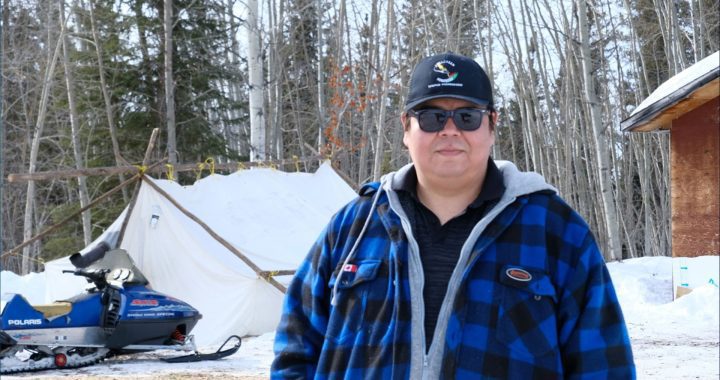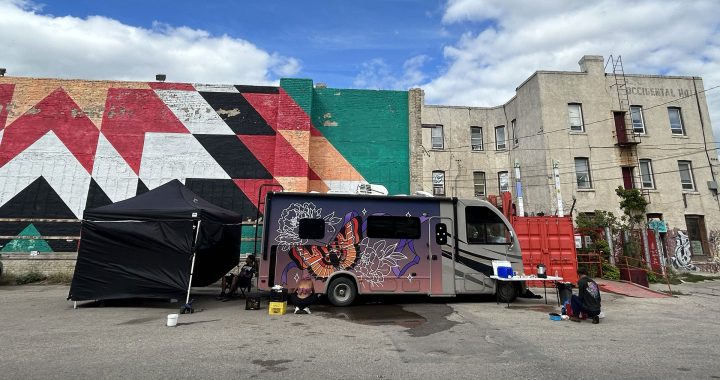(Rebecca Iahtail (left) and Attawapiskat Chief Theresa Spence (right) at the diamond mine ice road blockade on Friday night. APTN/photo)
By Jorge Barrera
APTN National News
ATTAWAPISKAT– Inside the wood stove-warmed canvas tent beside the barricades on the ice road leading to the De Beers diamond mine, Rebecca Iahtail says she’s dying from cancer.
There are several women sitting around Iahtail, three men, including Iahtail’s partner Noah, at the tent’s entrance. The conversation is almost totally in Cree.
Spruce boughs and canvas are used as ground cover. Inside the tent a single candle burns next to an ashtray and an empty coffee cup. The flame glints softly off Iahtail’s glasses, her round face half shadow, half glow.
The wood stove pops and hisses. The tinny sound of a pop tune can be heard coming from the headphones of a teenage girl.
It’s Friday night in Attawapiskat, day six of the blockade is about to come to an end.
Exhaust fumes, illuminated by headlights, float across the ice road. Tail lights streak through the darkness. A number of SUVs and pick-up trucks are buzzing between the barricades and the community, which is a couple of kilometres away.
Iahtail says she has colon cancer and was given three years left to live. A mother to an 11 year-old son who is in Moose Factory at a hockey tournament, Iahtail says her impending death is part of the reason why she’s decided to stay until the end.
“I got to do something,” says Iahtail. “I know I don’t have much time left.”
She’s the last of the original blockaders.
The other men involved decided to step down after a meeting late Friday afternoon with Attawapiskat Chief Theresa Spence and her band council.
They were handed a letter asking them to stop the blockade because De Beers planned to launch an $130 million lawsuit against each of them.
“Chief and council understand your frustration with De Beers in not dealing with your grievance matter,” says the letter, signed by Spence. “However, we cannot endorse any actions that prevent De Beers from operating its mine pursuant to our Impact Benefit Agreement.”
The Impact Benefit Agreement (IBA) is at the root of the current blockade, the second one in as many weeks.
The community members involved say the IBA agreement is bad for Attawapiskat and doesn’t give the community enough for the use of the diamond riches on their traditional territory.
Inside the tent, Danny Metatawabin, the IBA coordinator, uses his gloves to outline the Victor mine site and points out De Beers is also looking to exploit another area called “Tango.”
Metatawabin says the company will have to negotiate a new IBA and, based on the problems the community sees with the current deal, the Attawapiskat government will be looking to land a better agreement.
Iahtail, however, doesn’t want to wait four more years for a better agreement. This is her stand, she says, and the blockade won’t end even if she’s taken away.
“I know there is a lot of people that are going to come back,” she says. “They told me they are going to keep blockading…They are going to keep on. After they take me they are going to keep blockading. Are they going to take the whole reserve out? Build an Idle No More prison?”
Others have told APTN National News that people know Iahtail is sick and they will stand behind her if the OPP comes to take her away.
Spence was briefly at the site Friday night. She and her council said during the meeting earlier in the day that they couldn’t officially support the blockaders because it would open up the band to a massive lawsuit from the company.
In an interview with APTN National News, Spence says she marked “No” on the ballot during the IBA vote in the 2005. She says there are problems with the agreement, but the band needs to work them out with De Beers.
“I understand what the blockaders are saying, but we have to look out for everyone and protect them,” she says. “I understand their frustration, but we need to stand together if we are going to fight De Beers.”
Iahtail, however, feels she’s been abandoned by Spence. It was Iahtail who cast the deciding vote putting Spence in as chief in 2010. Spence was tied in the race for chief with Greg Shisheesh and Iahtail, as the election officer, cast the tie-breaking vote.
Iahtail and several of the women inside the tent also helped install a teepee in front of the band office in support of Spence’s six week fast on an island in the Ottawa River.
“How come she’s not supporting us, why is she backing away?” says Iahtail.
By late Saturday morning, the blockade site is again alive with vehicles and visitors. Someone has brought food for Iahtail.
It’s now day seven.
De Beers claims the blockade is threatening its operations for the rest of the year.
The mine ships up about 11 million litres of fuel up the winter road every year, along with machinery and parts too heavy to fly into the mine’s airport.
The mine also uses the winter road to truck-up hazardous substances like ammonia nitrate and truck out “hazardous waste material” that can’t be flown out of the mine.
But the ice road to the diamond mine remains shut to De Beers.
“Enough is enough you know,” says Iahtail.
@JorgeBarrera










Respect!!!
Where is the real news? What is the problem with the IBA agreement? Why are people upset? I get the idea–Spence is between a rock and a hard place. Would you kindly describe the rock and the hard place?
God Bless you all be you right or wrong. I understand suffering and oppression. I can’t understand how you could be so misstreated. Surely the Lord is using your nation to bring shame upon the government. I pray for gentleness to be restored to negotiations and that pride and happiness will fill your hearts soon. xoxo
In my humble opinion, companies like De Beers should be honor bound to provide housing to each and every person on the reserve. I just think it’s the right thing to do. The company is worth how many billions of dollars??? For heavens sake you can’t take it with you. So why not do the right thing and fix the housing issues in Attawapiskat?? From what I have learned some of the problems were caused by De Beers anyway. The sewage back up was because of De Beers so fix the problem. I don’t care if it’s not their responsibility or not. If I had the money De Beers had and I lived up there, I most certainly would fix the housing problem in Attawapiskat. It’s the right thing to do, whether it’s their responsibility or not. Help out fellow human beings it’s as simple as that.
For a protest to be effective, you have to stop traffic. You
have to stop traffic.
Naomi Wolf talks about the barriers to authentic protest and
what it takes for a real protest to succeed:
OK. So what kind of mass protest? The kind of mass protest
that always works is illegal just about everywhere in the United States today.
Why is that?
What keeps you from getting a permit in the United
States? Stepping a foot into the street.
http://youtu.be/ubeLAJjZ4wQ
Now why do you have to stop traffic? Because for a protest to do anything, it has
to disrupt business as usual. I don’t
mean violence. (Whoever’s tape-recording
this to take it back to, you know, Quantico or whatever, I don’t mean violence.
I mean dissent.)
Martin Luther King, who wrote “Letter from Birmingham Jail”
because he marched without a permit, said sometimes it is important for the
tension to rise up for people to see all is not well. And that you do that by stopping traffic. That’s how citizens indicate, you know,
business as usual is not acceptable.
It’s an exercise in stifling debate and blurring the line
between legitimate protest and terrorism. They want people to be afraid of those who
speak out against government policies. Then
they can throw dissidents into all of those jails they want to build.